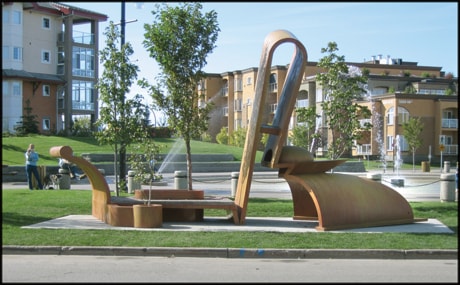Red Deer-raised sculptor Royden Mills creates the kind of art he once shook his head over.
One of his more whimsical installations, Inside Elevation, is wryly described by Mills as a cross between a perfume bottle and a telephone booth-sized temple.
The large metal sculpture — inspired by a sense of vulnerability and the need for privacy — is visually interesting enough to have been recently chosen to permanently stand among some of the best artworks in North America at the Grounds for Sculpture Park, south of New York City.
Mills is thrilled with the honour, saying “If one of my pieces is worth taking up valuable space in their park, sitting where people might be inspired by it, then it’s a pretty big deal. I feel like I’ve accomplished something.”
But he admits his enigmatic work resembles the kind of abstract public art that once left him perplexed.
The most prominent feature of Inside Elevation is a narrow doorway that’s exactly Mills’s dimensions — 1.75 metres tall and 28 cm wide (five-foot-nine inches tall and 11 inches wide).
“I was playing with the idea of exclusivity,” said Mills. “Some people will be wanting to get in, but they are too big.”
Mills now lives in Edmonton and teaches art at the University of Alberta. But during his student days in Red Deer, he remembers several large, assemblage sculptures being brought to the city in celebration of Alberta’s 75th anniversary in 1980.
Mills was among many Red Deer residents who didn’t see their value. “They looked like train wrecks or car accidents to me,” he recalled with a chuckle.
“I remember thinking that if art is like music, then Red Deer is a country music town and they’re bringing in all this jazz. Why are they doing that?”
But he eventually came to appreciate the artistry of line, form and shape inherent in many non-representational sculptures.
“If they had never brought the jazz in, I would never have realized that jazz was for me,” said Mills, who soon enrolled in the Red Deer College visual arts program and began experimenting — first with figurative sculptures, then with abstract ones.
He found a lot of satisfaction in creating art unrestricted by the confines of realism. “They can be sophisticated visual concerns that are expressive of a human being’s power and potential.”
The two years he spent at Red Deer College “changed my life,” said Mills, who went on to finish his bachelor and master’s degrees of fine arts at the University of Alberta.
He now has sculptures displayed around Edmonton, as well as one in Red Deer’s downtown Centennial Park, at the very west end of Alexander Way.
Red Deer Line was inspired by a train engine because the pioneer that Alexander Way is named after was a railroad worker. Mills created a trailing end to the sculpture to give the impression of a low row of railcars.
He wanted trees to grow through spaces in the sculpture to give the sense of a train being locked down to the tracks. Like a pioneer who set down roots, “the trees tie it to the ground,” said Mills.
The artist and his wife Linda, an elementary school music teacher, spent two years in Japan and Mills believes he owes some of his inspiration to Asian art.
He also owes some of his creativity to his father, who not only owned a vacuum cleaner manufacturing shop in the city, but also invented a new kind of built-in vacuum system he sold to Electrolux Appliances. “He was a pretty crafty thinker,” recalled Mills, who lived in Fairview and dreamed of being a hockey player as a child.
Some early health concerns ruled out a hockey career, but gave Mills an appreciation for life and sense of urgency that he needed to be doing something he loves.
The same intuition is now telling the sculptor it could be time to leave teaching and focus exclusively on creating art. “I need to stop hedging my bets,” said Mills, who’s part of a consortium of three artists who get regular commissions for public art from an Edmonton engineering firm.
Getting artists involved at the ground level as projects are planned is a very European thing. Mills compares it to the kind of artistic urban planning that built Paris and Rome.
While some Central Albertans continue to object to public funds being spent on public art, Mills believes it’s a necessary, not frivolous expenditure.
Not only do artists help stir the economy through their material purchases, he said, they also have the potential to turn Alberta into an interesting, beautiful place where tourists will flock long after the oilfields have gone dry.
lmichelin@www.reddeeradvocate.com
